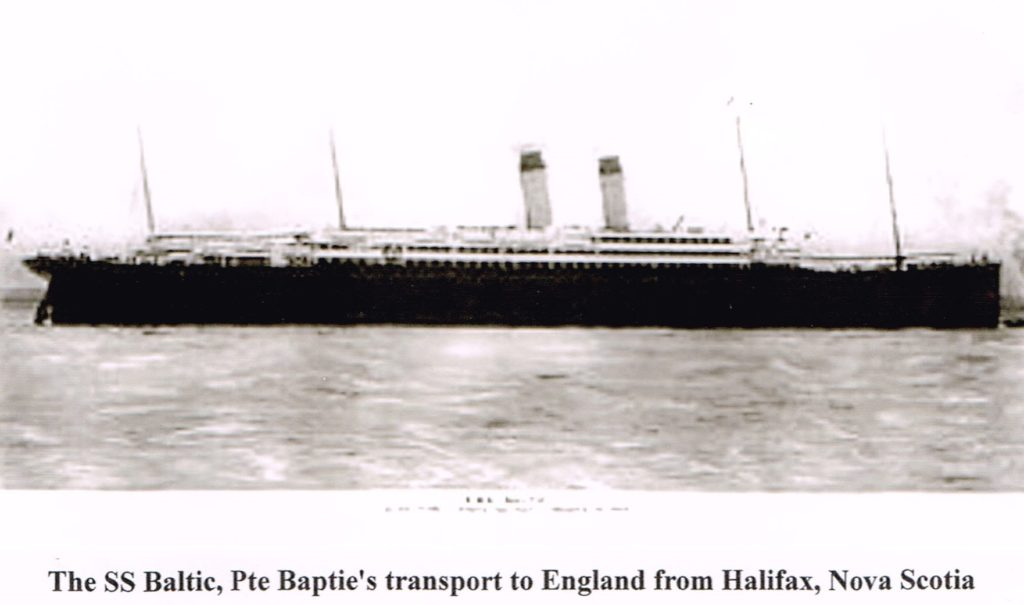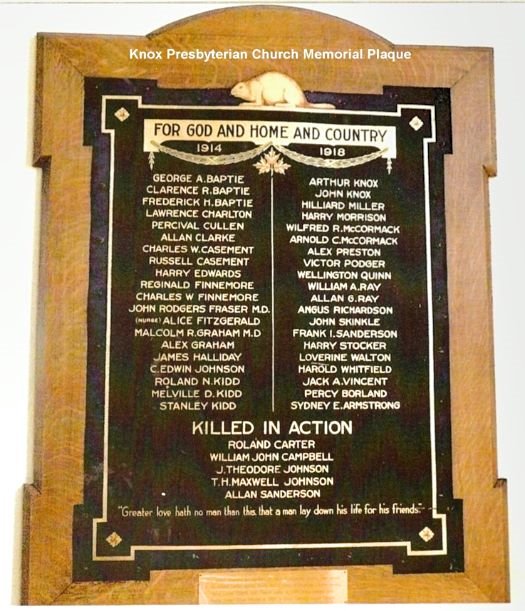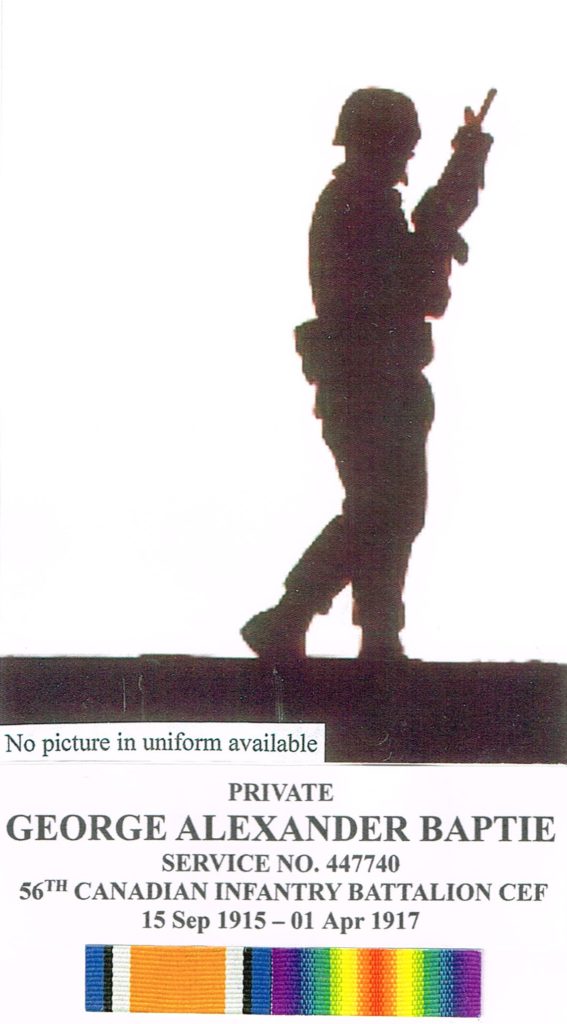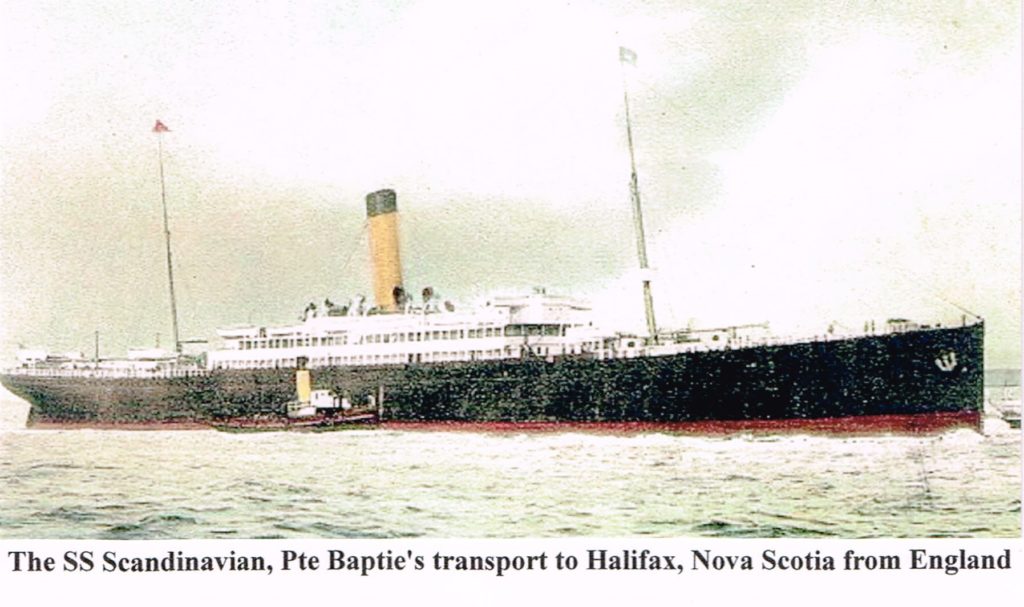MILITARY HISTORY
Private George Alexander Baptie — 447740 — ACTIVE SERVICE (World War I)
George Alexander Baptie was 44 years, 1 months and 24 days old when, as a married man, he was Attested in the Canadian Army (CA), Canadian Expeditionary Force (CEF) in Calgary, Alberta and was enlisted on April 21, 1915 into the 50th Overseas Battalion (Bn), CEF. George Alexander was born in Lakefield, Ontario on July 28, 1871*. He was 5′ 4″ tall, weight was not given, blue eyes, dark hair and had a 33½” chest (expanded). George Alexander gave his occupation as a Carpenter and his next-of-kin was his wife Mrs. Elizabeth J. Baptie, living at 532 8 Ave N.E., Calgary; he indicated that he had no previous Military experience. In May 1915 a Separation Allowance of $20.00 monthly was instituted by George Alexander to his wife Mrs. Elizabeth J. Baptie. George Alexander’s Medical Examination was done in Calgary on September 21, 1915, he had: a scar (Varicocele); the 3rd digit, right hand amputated and the first joint of left thumb amputated. Regardless of these conditions he was found fit for duty. On September 15, 1915 he was assigned the Rank of Private (Pte); given Regimental Number 447740 and taken-on-strength to the 56th Bn, “C” Company (Coy). *It is believed that George Alexander’s actual date-of-birth is July 28, 1865 and that he gave 1871 in order to qualify by age.
On October 25, 1915 Pte Baptie was struck-off-strength from the 50th Overseas Bn, “C” Coy CEF to the 56th Overseas Bn, CEF.
On March 1, 1916 Pte Baptie indicated that he had Insurance and the premiums were being paid. March 23, 1916 he embarked the SS Baltic at Halifax, Nova Scotia and on April 11, 1916 Pte Baptie disembarked the SS Baltic at England. Although not stated in his File, he would have been taken-on-strength with the 56th Bn, CEF in England.
On May 7, 1916 Pte Baptie was admitted to the Moore Barracks Hospital at Shorncliffe, England with a headache and Bronchitis. During his 15-day stay in the Hospital he was subjected to many tests. He was having congestion in his lungs which were clearing but he was still coughing. Pte Baptie was discharged May 22, 1916, a member of the 56th Bn “A” Coy and was transferred to the Canadian Convalescent Hospital (CCH) at Epsom, England under the authority of the Commandant Staff of the 55th Bn, “A” Coy. June 27, 1916 at Woodcote Park Epsom, England he is discharged from the CCH to the 56th Bn at Bearwood, Workingham, England. July 6, 1916 Pte Baptie is transferred to the 9th Reserve Battalion (Res Bn) at Shorncliffe and was taken-on-strength with the 9th Bn. July 19, 1916 he was struck-off-strength from the 9th Bn to the Canadian Casualty Assembly Centre (CCAC) and attached to the 9th Bn for PBG. The CCAC is a centre where wounded were assessed for either further treatment or return to duty. Also on July 19, 1916 he was taken-on-strength with the CCAC and On-Command to the 9th Bn. December 7, 1916 Pte Baptie was taken-on-strength to the 64th Bn from the 9th Bn and December 12, 1916 he was ceasing to be attached on transfer to the 64th Bn.
January 2, 1917 a “Medical Report on an Invalid” was done on Pte Baptie at Shoreham, England; he was with the 64th Bn, 51 years old and with the following Disabilities: Bronchitis; Lumbago; Deformed right hand and Age. Pte Baptie was fit to be invalided to Canada by the Review Board.
January 31, 1917 Pte Baptie was struck-off-strength on transfer to the Canadian Discharge Depot (CDD) in Québec. The CDD is a centre in Canada where soldiers, returning from War, were released from Service. February 11, 1917 he was struck-off-strength from the CCAC on proceeding to Canada for discharge and ceases to be attached to the 9th Reserve Bn at Hastings, England. From February 7 to April 1, 1917 Pte Baptie was at the Discharge Depot (DD) in Québec with the 56th Bn. On February 17, 1917 Pte Baptie embarked the SS Scandinavian and sailed from Liverpool to Québec where he would disembark about February 27, 1917. On March 1, 1917 all payments were stopped. On April 1, 1917 Private George Alexander Baptie was discharged, being no longer physically fit for War Service, from the Canadian Army (Canada) at the CDD in Québec, Canada to return to civil life on demobilization. He was granted a $100.00 Clothing Allowance, a Rehabilitation Grant, War Service Gratuity and his Post Discharge Pay of $112.67. Edward Henry’s Post Service address was168½ Charlotte Street, Peterborough Ontario.
There is no mention in Private George Alexander Baptie’s File with regards to what Military Medals he was eligible to receive or was awarded. Based on his Military Service, he was awarded the:
British War Medal; and
Victory Medal.
He would have also received the CEF Class “A” War Service Badge.
George Alexander Baptie’s medals were dispatched to him on November 21, 1925.
Private George Alexander Baptie served for: 7 months, 5 days in Canada; 10 months, 6 days in the United Kingdom and 29 days Travel Time for a total time of 1 years, 6 months and 11 days.
An excerpt from an article in McLean’s magazine by Barbara Amiel, September 1996:
The military is the single calling in the world with job specifications that include a commitment to die for your nation. What could be more honorable?
PERSONAL HISTORY
GEORGE ALEXANER BAPTIE
George Alexander Baptie was born in Lakefield on July 28, 1865, the son of Mary Ann Barrie and Peter James Baptie. He received his education in the local school and helped his father in the building construction business. About 1887, George met Elizabeth “Libby” Jane Huffman, daughter of Hester Ann Johnson and George Huffman, when she was living with her family near the Trent Severn waterway in Fredericksburgh in Lennox & Addington County. George and Elizabeth became engaged that same year and made a handsome couple. He cut a dashing figure with his dark suits and chevron style moustache and Elizabeth had up-swept hair and wore freshly pressed Victorian style dresses. They were married in Belleville on September 5, 1888. Then Elizabeth was introduced to a comfortable family life in Lakefield. She enjoyed their spacious home and had many close friends. George and Elizabeth had a family of ten children – Clarence Raymond, Flora Maud, Lola Huffman, Frederick Huffman, Peter Barry, Gertrude May, Ruth Caroline, Ruby Ethel, Marion Margaret and George Alexander Jr.
George and his father, Peter co-owned a planing and saw mill in Lakefield located south of the bridge and they oversaw the cutting of the lumber at their planing/sawmill until 1892 shipping lumber by CPR freight across the country. They also built several homes on Regent Street in the village as well as the building contractor for the first brick town hall. As builders, George and his father had connections to many areas across the country. They were known to Samuel Strickland’s family and were connected to them through business ventures.
In 1892 George, his brother William and his father Peter took a working trip by train west through Manitoba, Saskatchewan and Alberta where they had an opportunity to scout for business. They were building barns and dance halls along the way, but this area was yet largely undeveloped so they didn’t stay. In 1897, the Baptie brothers passed through Alberta again on their way to the Klondike with their group of workers. George and William went there with some of the Stricklands and they were heavily relied on for just about everything, which included bringing up shipments without benefit of rail or road travel. George and his brother William were essential financial backers of the expedition and oversaw the construction projects of cabins, boats and shelters. The expedition was sponsored by Charles Tupper’s company Klondyke Mining, Trading and Transport Corporation.
With the men gone for a time, Libby was quite busy with their children. She was the mainstay of their lives and did the lion’s share of managing the home. Libby was a skilled mediator who enjoyed being around her children. Libby kept the lines of communication open to maintain business connections for her returning husband. After several long winter months of conquering the elements, eg. ascending the Chilkoot Pass, dog-sledding, exploring/building, and managing the groups of men – it was time for George and William to leave. They were delayed when a boat carrying NWMP and government inspectors overturned, and William gave them a boat, in return for provisions for the duration. They had to build another boat to leave, which, given Yukon winter conditions – was a major undertaking.
When they returned to the Lakefield area, they continued building in the town of Peterborough as well the county, where the J.D. Baptie mill was situated. As co-directors of Lakefield Canoes they rebuilt the factory when it burnt down in 1910. The new brick building survived, but their time there was coming to a close.
In 1912, George and William came out West to prepare a place for their families to live. They built homes for prominent citizens in the Elbow Park and the CPR division of Mount Royal areas in Calgary. Since that effort was successful, they decided to move their families out with them within the year. By 1913 they had packed up everything plus the children and moved by CPR to the city of Calgary, Alberta. They came out for better opportunities for their large family reaching adulthood and the first home they lived in was a brand new 2 story house in the centre of town.
As the children grew up and moved away, Elizabeth stayed at home and worked on her quilts. In 1915, the oldest daughter Flora Maude graduated at the top of the class at the General Hospital nursing school, and Flora was a pioneer nurse too. First born son Clarence Raymond and younger brother Frederick Huffman both served in WWI, and returned safely. Elizabeth attended the nearby Rosedale United Church with her family, and in 1948, Elizabeth Jane and George Alexander celebrated their 60th wedding anniversary. Elizabeth passed away on February 26, 1950 and George died on February 19, 1953; both are buried in Union Cemetery, Calgary, Alberta.
(Detailed personal information courtesy of Leigh Best UE, Bay of Quinte Branch.
George Alexander Baptie was a member of Knox Presbyterian Church and is included on a Memorial Plaque that hung in Knox Presbyterian Church which remembers with honour their members who served in the Armed Forces during World War I. This plaque was later moved to the Sanctuary of Lakefield United Church on Regent Street in 1932 after the two churches merged to form Lakefield United Church.
THE GEORGE ALEXANDER BAPTIE FAMILY OF LAKEFIELD
George Alexander Baptie’s paternal great grandparents were Elizabeth Riddle and James Baptie of Roxburghshire, Scotland.
George Alexander Baptie’s maternal great grandparents were Margaret Agnes Dickson and Peter Currith.
George Alexander Baptie’s paternal grandparents were Walter Scott Baptie (1805) and Margaret Currith (1813). They lived in Harvey Township, village of Lakefield and later in Peterborough. They had a family of four children – James, Peter James, Elizabeth and Douglas Baptie. Walter worked as a blacksmith. Walter passed away on January 24, 1860 and Margaret died April 8, 1899; both are buried in Lakefield Cemetery.
George Alexander Baptie’s maternal grandparents were Mary Hurl (1821) and David Barrie (1813). They were married in 1840 and settled in Dummer Township where David farmed. They had a family of six children – Mary Ann, Nancy, Thomas James, Matilda Emma, David and Beulah Alice Barrie. David passed away on January 23, 1879 and Mary died in 1913.
George Alexander Baptie’s parents were Peter James Baptie, born about 1837 in Peterborough. While living in Smith Township, Peter purchased several building lots on Regent Street buying property at 8, 10, 14, 18 & 20 Regent Street plus 31 & 37 Rabbit Street as well as all the property on Baptie Lane. Peter moved to Lakefield in 1861 and soon became a prominent local builder and contractor building many homes and barns in Lakefield and the surrounding area. Peter met Mary Anne Barrie, born February 2, 1841 in Dummer Township. They were married in Peterborough on July 31, 1862 and made their home in Lakefield. They had a family of six children Margaret Jane, George Alexander, Emma Elizabeth, William John, Mary Edith and Agnes Maude Baptie.
In 1865 Peter was hired as a carpenter for the construction of St. John the Baptist Church located on the corner of Regent and Queen Streets. Peter built and lived in the home at 14 Regent Street from 1868 until 1876 when the family moved to 18 Regent Street. By 1876 Peter and his family were living at 18-20 Regent Street. In 1884, Peter built a 30′ x 50′ planing mill and sash and door factory south of the bridge. The machinery included a shaper, lathe, two planers, moulding machine, blind lot tenoning machine, power mortising machine, band saw and three circular saws. The power for all of this equipment came from a 50 inch water wheel. Peter worked as a builder on several undertakings with Thomas Gordon. Peter passed away on July 4, 1899 age 62 years and Mary Ann died on September 15, 1929 age 88 years; both are buried in Lakefield Cemetery.
George Alexander Baptie was a member of Knox Presbyterian Church and is included on a Memorial Plaque that hung in Knox Presbyterian Church which remembers with honour their members who served in the Armed Forces during World War I. This plaque was later moved to the Sanctuary of Lakefield United Church on Regent Street in 1932 after the two churches merged to form Lakefield United Church.


